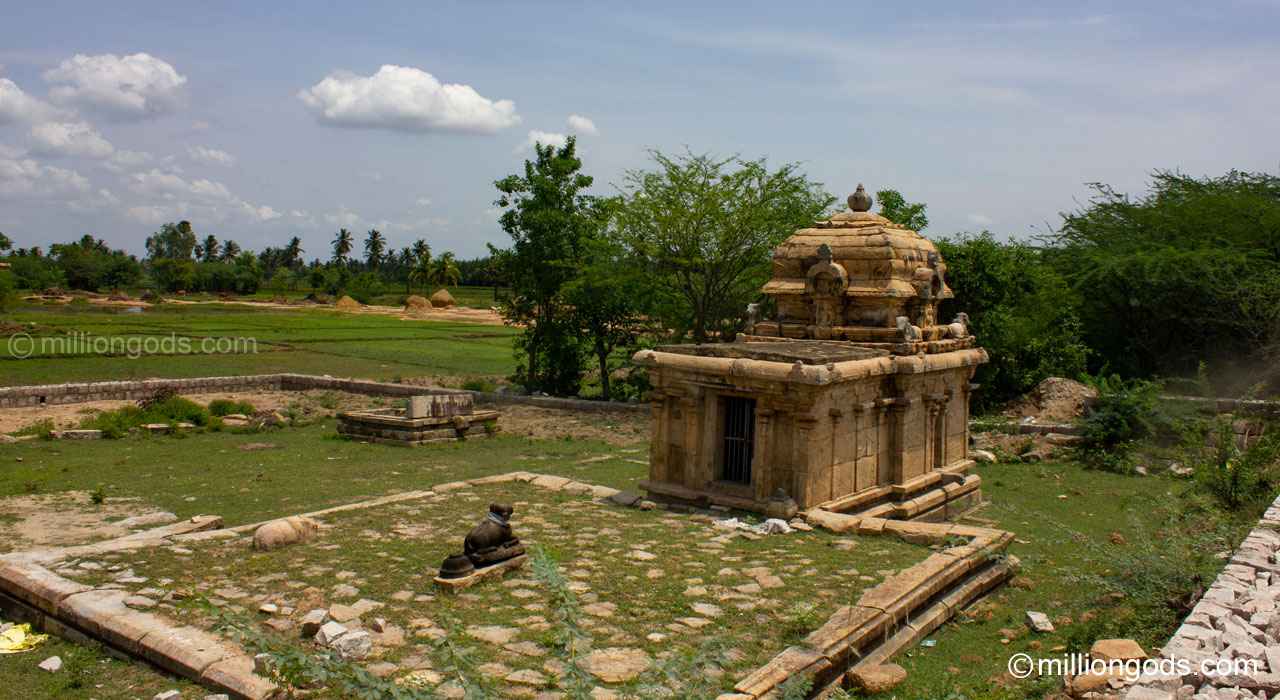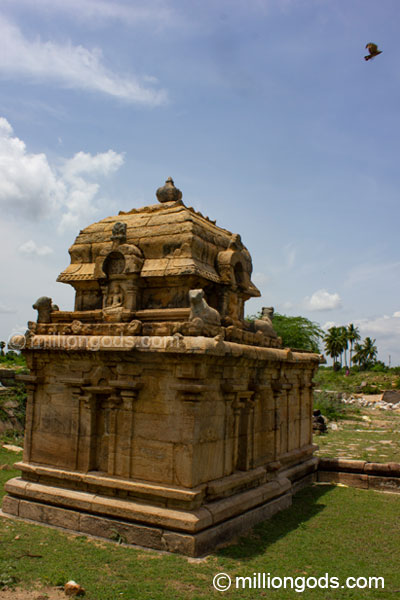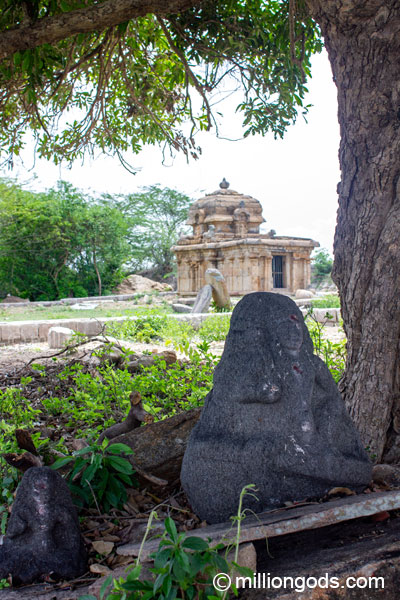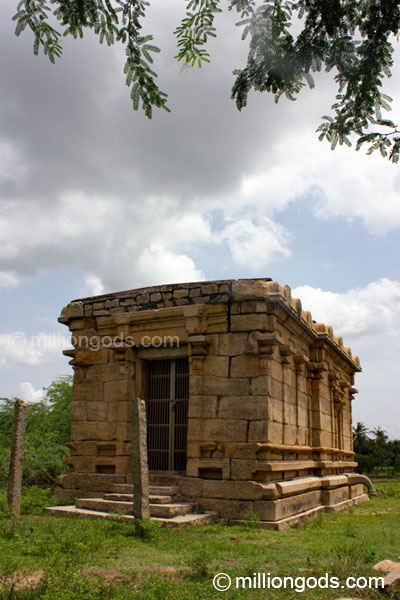Agasteeswarar, facing east
Agasteeswarar Panangudi
Agasteeswarar, Panangudi
Saivite Temples, Pudhukottai District

God
Goddess
Sivakamasundari
Other Deities
Vinayaka, Subramanya, Maha Vishnu, Brahma, Jyeshta
Agasteeswarar Panangudi is an ancient east facing stone temple situated on the banks of the Panangudi Lake. The temple consists of the Sanctum Sanctorum, Ardha Mantapa with a Nandi outside. The Mukha Mantapa connected to the Ardha Mantapa is seen only in the foundation part. A Nandi Mantapa in front is now seen only in remnants. The Shikara above the Sanctum sanctorum has four niches on the four sides. In these niches, Indra (or Subramanya) is found in the east, Dakshinamurthi in the south, Vishnu in the west and Brahma in the north. It is understood that there used to be 8 sub-shrines around the main temple. All the idols of the sanctum niches have been lost and a few other idols were discovered buried around the campus. The main deity is said to be a Swayambu. Nearby is an equally old Vishnu Temple called Panangudi Vinnagaram with only the Sanctum Sanctorum present.
Mr.S R Balasubrahmanyan reports finding various sculptures from the site including that of four Nandis, an image of Jyestha, Ganesha and a Naga. The Images of Nandi are now placed at the respective position over the Griva on the Vimaana. The images of Jyestha and Ganesha are placed inside the temple. He also mentions that it is usual for the early Chola temples to have sub-shrines conforming to ashta-parivara devatas, including Surya, Sapta-matrikas, Ganesha, Kartikeya, Jyestha, Chandra, Chandikeshvara and Nandi. Discovery of an image of Jyestha suggests that this temple was once adorned with eight sub-shrines. Remains of one such sub-shrine are identified at the site.
Holy Water (Theertham) – No information
Sacred Tree (Sthala Vriksham) – No information
Vimaanam – Sudhdha Vimaana



History
Agasteeswarar Panangudi was originally thought to have been constructed by the Cholas somewhere in the 9th Century CE. Subsequent research and studies suggest that the temple along with the nearby Vishnu Temple were first generation temples constructed by the Muttaraiyar Kings. These first-generation Muttaraiyar temples used to have Ashta (eight) Parivara Shrines around the main structure. In the earliest inscription at the temple, the deity is referred as Panangudi Paramesvaran. It is not certain when the deity started being referred as Agasteeshvara. S R Balasubrahmanyam assigns this temple to the period of the Chola King Vijayalaya (848-871 CE).
Douglas Barrett (1917–1992) a specialist in Islamic and Indian art, and Keeper of Oriental Antiquities at the British Museum writes, “The very simplicity of design may, of course, be misleading. Moreover, the loss of the main devakoshtha images and the dvarpalas and the little evidence of style to be derived from the four small, abraded images in the griva, make it impossible to insist on too precise a dating.” He assigns the temple to about 875 CE, and he says if one is unwilling to identify Parakesarivarman of the inscription with Vijayalaya (848-871 CE), it may fairly be given to Parantaka I (907-950CE).
K V Soundara Rajan who served as Superintendent of the Chennai circle and later, a Joint Director General of the Archaeological Survey of India, assigns this inscription to Parantaka I, however he places the temple earlier than Vijayalaya, in the second quarter of the 9th century CE during the reign of the Muttaraiyars of Nemam and Sendalai. He favors that the temple would have been constructed during the Pandya reign prior to the rise of Vijayalaya.
Inscriptions – There are three inscriptions found in the Agasteeswarar Panangudi temple.
On north wall – Except the regnal year and the name of the monarch, nothing much can be gathered from this ruined inscription. The inscription is dated in the 14th regnal year of a certain Parakesarivarman. The inscription could be dated to 9th or early 10th century CE. In this inscription, the deity is referred as “Panangudi Paramesvaran”. Balasubrahmanyam identifies Parakesarivarman of this inscription with the Chola king Vijayalaya (848-871 CE), however Soundara Rajan favors the identification with the Chola king Parantaka I (907-955 CE).
On the west wall – Written in Tamil, only ten lines are extant – date is lost, refers to the reign of the Chola King Kulothunga III (1178-1118 CE) – “Hail! Prosperity! (In the ….year of Tribhuvanaccakravartikal Sri Kulottunga Cola Devar also called Ko-Parakesaripanmar), who put on the magnificent crown, in order to protect the country for a long period of prosperity, while the rains were abundant and fertility of the land increased, while the following of the four Vedas, which are true for ever, prospered, the Goddess of Fortune and the Goddess of Victory abode in all glory, his golden parasol, white like the moon, was brilliant, the vanquished kings worshipped at his feet, the Goddess of the earth rejoiced in her heart, the Code of Manu prevailed in all glory, and the authority of his discus and sceptre spread in all diections. Who sent an army, at the request of Vikrama Pandiyan, and disfigured the face of the son of Vira Pandiyan……”
On the north wall – Written in Tamil in 28 lines but incomplete – dated in the fourth regnal year of the Pandya King Maravarman Kulasekara Pandyan (1268–1308 CE) alias Sri Kulasekharadeva – records the fixing of the assessment on a devadana land by the temple trustees and the residents of Panangudi in Konadu.
Legend
No information
Directions
Agasteeswarar Panangudi is about 11 kilometers northwest of Pudukottai off the road going towards Viralimalai via Annavasal.
Stay and Food
None locally. Pudukottai and Thiruchirapalli are the nearest.
